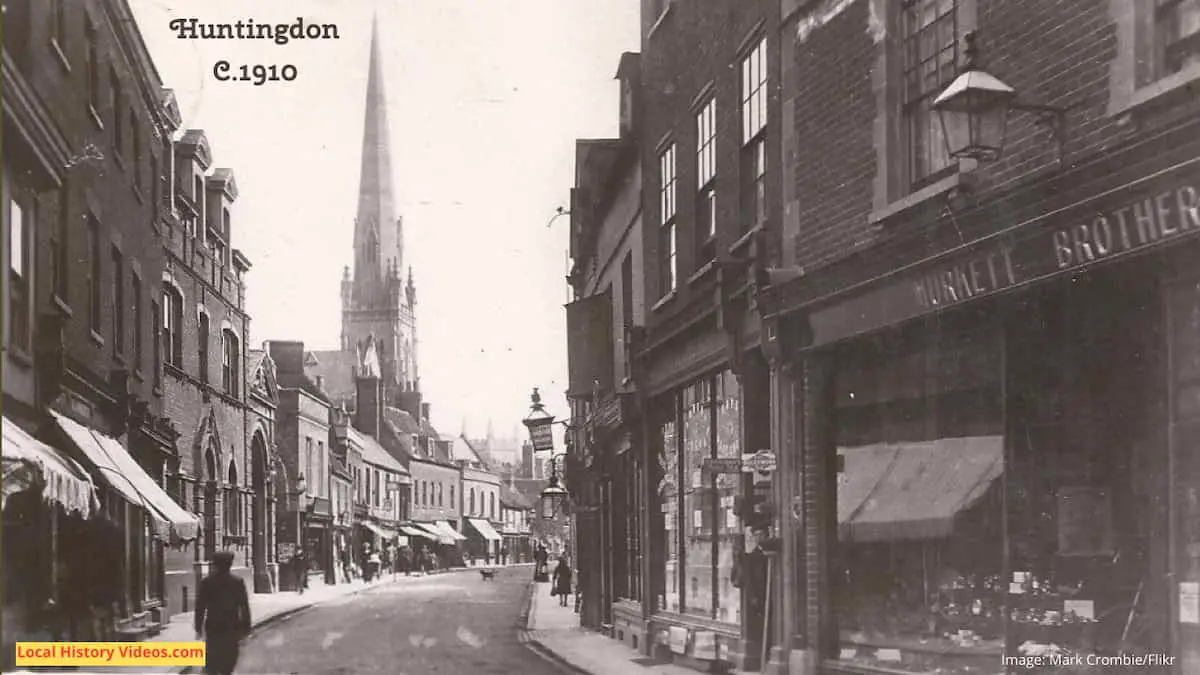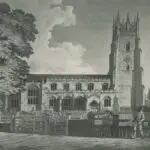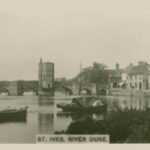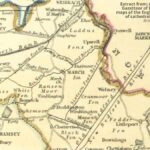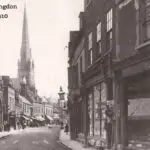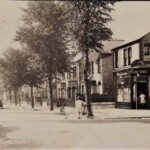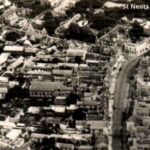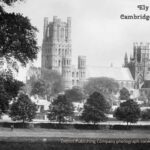Glimpse history through old images of Huntingdon, Cambridgeshire, England.
Barbara Meadows (1940)
During World War II, the bombing raids on Britain’s towns, cities, industrial and military targets destroyed entire neighbourhoods, especially during the Blitz of 1940.
Billeting Officers were sent out to Huntingdon’s householders, seeking available beds for homeless individuals and families fleeing London. It was far from easy; apparently 17 local men resigned from the role.
20 year old Mrs Barbara Meadows stepped in, determined to use tact and persuasion, and if that failed, then resort to compulsion.
Youngest Woman Billeting Officer (1940) – British Pathé on YouTube
Huntingdon in 1944
Filmed during World War II, this newsreel shows various historic buildings and streets, including the Elizabethan Hinchingbrooke House, Oliver Cromwell’s birthplace, the Grammar School, the George Hotel, the Falcon, and the Market Inn. There was an American social club too.
Huntingdon Issue Title Is Good Hunting (1944) – British Pathé on YouTube
A bit of Huntingdon history
Extract from “The American Traveller’s Guide – Harper’s Hand-book for Travellers in Europe and the East… Twelfth Year”, by William Pembroke Fetridge
Published in 1873
Page 106
Huntingdon contains 6000 inhabitants.
It is a very ancient town, and was formerly a Roman station.
The remains of a castle erected by Edward the Elder in 917 are still visible.
It contains a town – hall, assembly – rooms, and theatre.
One mile from the town is the residence of the Earl of Sandwich, which formerly belonged to the Cromwell family.
A short distance farther is Brampton Park, the handsome residence of the Duke of Manchester.
Extract from: “The History of Huntingdon, From the Earliest to the Present Times”, by Robert Carruthers
Published in 1824
Page 285 – 306
The Town Hall.
The Town Hall is a large and handsome pile of building, erected in the year 1745, by voluntary subscription, to which the Earl of Sandwich contributed £ 500. And Baron Clarke £ 300. It was erected on the site of the Old Court House, below which was a range of shops, and above a school room, wool chambers, and graineries. The materials of the old edifice were employed in the construction of the new, which is built of brick, stuccoed and coloured in imitation of Portland stone. In 1817 additions were made to the fabric and the whole extensively improved. The County having agreed to erect a sort of Anti – room in front, the Corporation proposed to carry up the building in order to form a Tea – room; which was accordingly carried into effect, the Corporation having advanced £ 200. for the purpose. Piazzas extend round the whole, which are no less useful than ornamental, being appropriated to the various purposes of the weekly market. The front is used by the retailers of eggs, butter, & c. and at the back and ends are the butcher’s shambles, noted for their excellent display of meat.
Above is the Assembly Room, a splendid apartment, 63 feet in length and 24 in breadth, furnished with three beautiful crystal chandeliers and numerous mirrors; and ornamented with full – length paintings of George H. and George III. with their Queens, and of John, the celebrated Earl of Sandwich, who died in the year 1792.
The Royal Portraits were partly executed, it is said, by Sir Joshua Reynolds, who contented himself with portraying the”human face divine,”and left the more subordinate department of drapery, & c. to be supplied by his assistants. The portrait of Lord Sandwich, which contains a distant view of St. Paul’s in the back – ground, was painted by Gainsborough, an artist of original and very superior genius.
From the Assembly Room we enter by a pair of folding doors into the Tea Room, which has been added to the building by the late extensive improvements. The Tea room is 30 feet in length and 24 feet in breadth, and contains a superb crystal chandelier, purchased at the expense of the late Earl of Sandwich, who contributed £ 100. towards ornamenting this room.
Below are the Courts of Justice,”regions of woe, doleful shades,”which contrast strongly in moral effect with the upper apartments: one room is appropriated to the trial of criminal and the other of civil causes, and each is accommodated with a gallery.
The Assizes are held here twice every year; generally in March and July though it occasionally happens that they are later. Huntingdon is in the Norfolk circuit. In the Crown Court the general Quarter Sessions for the town and county are held, and in the Nisi Prius, the Sheriff’s or County Court, is held every fourth Saturday. In the Grand Jury Room, the Magistrates sit every week for the dispatch of business, and adjoining it, directly under the Tea Room, is a Lobby for the reception of witnesses, & c. which forms part of the valuable improvements of 1817. In front of this room, and overlooking the square of the Market – place, is a small balcony, consecrated to the use of gentlemen who make speeches, for the benefit of their country, at the time of an election. For the exterior appearance and ornaments of the Town Hall, we refer our readers to the correct and masterly engraving prefixed to this volume.
County Gaol.
The Gaol is situated in High Street, near the Bridge and is calculated to contain 22 Prisoners on the Crown side, and 10 on the Debtor’s side. The Keeper’s house stands in front towards the street and the Gaol is placed behind it: anciently the prison extended to the street, and the prisoners solicited charity from those passing by, in the manner of the Fleet debtors.
There are no separate cells or sleeping rooms in our Gaol, and the sleeping place appropriated for the men felons is underneath their day – room, to which they descend by a flight of steps through a trap – door.
The felons ‘ day – room is about 16 feet square and 10 feet high; and has a fire place with two iron – grated windows. Their courtyard is about 21 feet square. The women felons ‘ day – room is about 13 by 10 feet, and their sleeping room the same. Their courtyard is 28 by 17 feet. There are two sleeping cells for deserters. There is no classification of the prisoners excepting the simple and obvious one of males from females, and felons from debtors. Irons are used on such criminals as are committed for capital offences, and the keeper is allowed to punish refractory prisoners by solitary confinement, or using heavier irons.
The allowance made by the county to the criminals is 2 quartern loaves and a half per week each, and the only bedding is sacking stuffed with straw, without any covering; but the prisoners are allowed to bring better bedding into the prison with them. They may also have provisions brought to them, and may purchase one quart or three pints of beer in the course of the day each; but no more. The prisoners are not employed in any kind of work but are allowed to amuse themselves in playing with balls if they please; and their friends and visitors are admitted if they behave well.
The accommodation for Debtors, both male and female, is singularly complete and excellent, considering the size of the Gaol.
There is no Chapel in this Prison, but one of the rooms belonging to the prisoners is appropriated every Wednesday morning for Prayers and Sermon. The prisoners are also provided with Bibles, Testaments, and Prayer Books. The present chaplain is the Rev. Thomas Brown. The prison contains an infirmary and a surgeon is engaged to attend when required. There is a pump in each court – yard, but no bath nor oven.
The present keeper of the gaol is Mr. John Cole, who succeeded to the office on the death of Mr. Aveling, in January 1820.
Crime unfortunately appears to be on the increase in this county, as in almost every other in the kingdom. In 1820 the number of felons was 27: in 1821, 34: in 1822, 44; in 1823 the same: from January of this year to the present time, ( 28th of October, ) 60 have been committed.
We are happy to state that it is in contemplation to erect a new gaol: the present being allowed on all hands to be utterly inadequate both for purposes of security and proper arrangement. Without a due classification of the prisoners, what improvement can be effected in their moral condition ?
If a boy of 12 or 14 years old, committed for some petty larceny, be compelled to associate freely with rogues and highwaymen, who have grown grey in the commission of crime, and whose conversation is chiefly made up of narratives of their past exploits, is it not obvious that he will return to society rooted and confirmed in those bad habits, which solitary confinement and whole some admonition might have wholly eradicated? Will he not benefit by the lessons and emulate the example of his more experienced compeers?
This gross deficiency in Prison – discipline is not, perhaps, so sensibly felt here as in more populous districts, but to a certain extent it must exist; and we earnestly hope it will be removed by the speedy erection of a new and complete Prison.
County Bridewell.
Though comparatively a modern building, and encircled with a wall 18 feet high, the Bridewell like the Gaol, is an insecure and incomplete Prison. It is situated in the N. W. outskirts of the town, in a retired, but unfortunately low and damp situation, and is calculated to contain 48 prisoners. The average number, however, is 18. There are 10 Wards; 1 day – room and 1 airing yard for males and the same for females. The airing yards are spacious and open. The greatest number ever confined here at one time was 32. In August 1823, a Tread Mill made by Medlock, St. Neots, was established here, and has, we are informed by Mr. Bowker, the Keeper, been attended with the most beneficial effects. Out of 149 prisoners committed last year, two only have been returned. The irksome and monotonous labour of the Mill is said to create the strongest disgust in the minds of the prisoners, and by bringing the bitter fruits of crime so”closely home to their business and bosoms,”must operate in deterring them from a renewal of their former offences. All harshness and severity in prisons cannot be too strongly deprecated, or too speedily removed; but there seems to be no foundation for the exceptions taken by some thin – skinned sensitive gentlemen against the discipline of the Tread Mill. If it be found to deter men from the commission of crime, and continues to be conducive to the health of the prisoners, these effusions of a spurious and sickly philanthropy must be disregarded by all “Men of the world, who know the world like men.”
No means of classification are practicable.
The weekly allowance for each prisoner is 10lb. of bread, 3 quarts of soup, peck of potatoes and lb. of salt.
The Workhouse
Is situated in Priory Lane, and is pointed out by the following Inscription affixed to the north end of the building:
“This Building and Premises, the Property of All Saints Parish, was made a Workhouse for the use of the Four Parishes in the Year 1804.”
The interior consists of a large day – room and sleeping – room for the men, and others for the women, who have also separate Wards when confined with sickness. The Master is allowed a certain sum for each pauper according to the price of provisions.
By Will, A. D. 1542,”Isabelle Davieson of the parishe of Seynt Bennets, bequeithes to the Beed – House of Huntingdon, a Payre of Sheats.”
The Theatre
Is situated at the end of the George Lane on the road leading to Brampton, & c. and was erected in the year 1800. The exterioris mean and inelegant: the interior has been recently fitted up with considerable taste, but is too small, we should think, to give adequate effect to scenic representations. The present Manager is Mr. T. Robertson, who is also Manager of the Lincoln, Grantham, and Peterborough Theatres. The Theatre here is always open during the Race Week and generally for a fortnight after. The Performers are in point of merit equal to the generality of those who”fret their hour,”upon the boards of a provincial theatre.
The principal Inns in Huntingdon are the Fountain, George, Crown, Cross Keys, and Falcon. There are two Banks, of which the firm of the one is”John and Charles Pasheller,”and that of the other”Rust, David Veasey, and David Veasey, Jun.”
In Priory Lane is a respectable Billiard Room kept by Mr. Duggen.
There are places of worship for the Quaker, the Independent, and Wesleyan Dissenters: the latter have a Sunday School, in which above 200 Children are instructed.
Huntingdon possesses no Newspaper peculiarly its own, but the Cambridge Chronicle, and Independent Press, are circulated here on the day of publication. The latter is published on Saturday, the former on Friday. They are both printed in Cambridge. The proprietors of the Independent Press have an office here over the shop of Mr. Grocer, opposite the Coffee House. The agency of the Cambridge Chronicle for this town, is conducted by Mr. Peterkin, Book seller.
The Stamp Office is situated in the N. W. corner of the Market Place, close to All Saints Church: the present Distributor is S. E. Cooch, Esq.
The Market Place, which is in the centre of the town, forms a spacious square, and the Market, held every Saturday, is well supplied and numerously attended.
The Post – Office is now established at the house of Mrs. Phillips, Market – Place, contiguous to the Town Hall. The London Mail arrives every morning at three o’clock, the Edinburgh Mail at eleven, at night. There is also a Branch Mail which runs from Boston to Cambridge and leaves this town about ten, every night. There are also Branch Mails to Chatteris, Cambs. and to St. Neots, Bedford, & c. The former is a Mait Cart and leaves here at past 3 in the morn ing; the latter is a horse mail and leaves at 5 in the morning. There is but one delivery of the letters, which commences every morning at eight o’clock. The present Postmaster is Mr. John Hatfield.
Few towns of the same size possess more convenient modes of conveyance to almost every part of the kingdom, as may be seen by the following enumeration. Daily Coaches to London, from the George Hotel; the Regent at 10 in the morning, Perseverance, at 12, Boston Mail, at 10 at night, Wellington, at past 10. From the Fountain, the Defiance, at 10 in the morning, Edinburgh Mail, at 11 at night, Defiance to Peterboro’ at 4 in the afternoon, Wellington, to York at 11 at night, Mails to Boston and Edinburgh, at 4 in the morning. From the George, the, Perseverance, to Boston at 4 in the morning, Rising Sun, to Northampton at 8 and to Cambridge in the evening at 7; Monday’s Wednesday’s and Friday’s Blucher to Cambridge at 10 in the morning, Old Cambridge to Leicester at 9 in the morning, and to Cambridge at 6 in the evening, Regent, to Stamford at 4 in the afternoon. Van and Waggons, to and from London daily, from Ashby’s Waggon Office.
The streets of Huntingdon are well paved and are lighted in the winter season by a small assessment levied on the householders.
The Police of the town is a very limited establishment, consisting only of two watchmen.
There are four Book Clubs in this town, the oldest and most respectable of which is the George Book Club, established in the year 1742. It consists at present of about 50 members, who meet and dine together once a month.
The Ladies ‘ Book Society, consisting of about forty subscribers, is held at the shop of Mr. Wood, Bookseller; where is also held the library of the Huntingdon Book Club, to which Lord Sondes and Lord John Russell are patrons and subscribers: the number of subscribers is twenty two. The Huntingdon Literary Society, established in 1817 and consisting at present of thirty – seven subscribers, is held at the shop of Mr. Lovell, Bookseller. Besides the above institutions, a general Circulating Library is kept by Mr. Peterkin, Bookseller; and a Reading Room in which are taken the principal daily and weekly London Journals and the local papers, has been recently established by Mr. Fox, Cabinet Maker. We are happy to add that these institutions are all in a flourishing condition, and evince the increasing spirit of enquiry and intelligence which pervades the town and its vicinity.
The Race Course is about five minutes walk from the Market – place, and is allowed to be equal to any in the kingdom. It is about two miles in circumference and is surrounded with the waters of the Ouse, with which it is overflooded in times of heavy rain. The races commence on the first Tuesday in August, and continue three days.
We have already spoken of the beautiful plain on which the races are held ( p. 66 ) and have only to add that it is private property and is in the parish of Brampton.
In Huntingdon is a depository of the Society for Promoting Christian Knowledge, and an Auxiliary Branch of the British and Foreign Bible Society ….
….The Savings Bank seems to call for a more extended notice. This admirable institution, so well calculated to impart and strengthen habits of industry, forethought, and independence in the working classes, and to raise their minds above that degrading source of pauperism, the Poor Laws, was established in 1818, on the plan generally adopted throughout the kingdom, and under the regulations prescribed by Act of Parliament. Deposits of not less than one shilling per week are received, which bear interest at the rate of four per cent, per annum; which is paid half yearly to depositors in May and November, or added to the principal if not called for, as soon as they amount to 12s 6d. No person is allowed to deposit more than £ 50. in the first year, and not more than £ 30. in any succeeding year.
The present Clerk to the Institution is Mr. Lovell, Bookseller, at whose Office the business of the Bank is conducted on Saturdays only. A branch – institution has lately been established at St. Ives. The amount of the Deposits at present, is between 19 and 20 thousand pounds, which is vested in Government Debentures.
The Monthly Assemblies commence in November and continue during the six successive months: they are well attended. Balls are also held during the week of the races.
The office of Clerk of the Peace, and of the Archdeacon of Huntingdon is in Prince’s Street: the business of both is conducted by William Margetts, Esq.
An Horticultural Society was estabilshed here in 1821, by a few practical and amateur gardeners, and such was the progress made in the furtherance of this highly useful and interesting art, that in the following year the Society was enabled to award Prizes for fruits and flowers. Since then it has rapidly increased, and bids fair to rival any provincial institution of the kind. The present number of members is upwards of 150; the yearly subscriptions from five shillings to a guinea. The President is John Maule, Esq. and the Secretary, Mr. James Wood. Annual, and other shew days are held, and numerously attended.
There are two Benefit Clubs in this town, the one held at the Cross Keys, and the other at the Royal Oak.
The present Inhabitants of Huntingdon, need not shrink from a comparison with their forefathers, or with the natives of any other place, in active, unwearied charity. In addition to the Institutions already described,a Lying – In, and a Clothing charity are supported here by the Ladies, and there are also the two following admirable establishments.
The Dispensary.
This highly meritorious Charity has for its object the administering medical advice and assistance, gratuitously, to such of the inhabitants of the county as are unable to purchase these inestimable benefits of themselves. It was instituted in 1789, and reestablished in 1796, and is supported by subscriptions, amounting to about £ 100. per annum, and by donations, the principal of which was a gift of £ 137. 18s. from the late Earl of Sandwich, £ 25. from Lord Viscount Milton, and £ 21. from James Rust, Esq. the late Treasurer, to whose exertions the Charity owes much of its present prosperity.
No less than 375 patients were admitted during the by – past year, 302 of whom were cured and restored to health. The success of this institution, to which every year, we are glad to find, adds additional subscribers, has enabled its governors, with some exertion, to purchase a Vapour Bath and Electrifying Machine for the use of the patients.
The present physician is Dr. Morton; the surgeons Mr. Wilson, Mr. Oakely, and Mr. Leslie. Patients are admitted every Saturday at the shop of Mr. Bates, druggist, and such as are unable to attend are visited by the physician.
It would be unjust not to add that in the Minute Book of the Charity, (for a sight of which we are indebted to the courtesy of the treasurer, David Veasey, Jun. Esq.) the subscribers are recorded as expressing at every meeting, the deep sense they entertain of the valuable labours of the medical gentlemen, who generously devote their time and talents, to lessen that load of pain and misery with which the poor are unfortunately but too familiar.
Charity
For relief of poor Widows and Children of Clergymen within the County of Huntingdon. This laudable Institution was opened by subscription, in the year 1748, but may be said to have been founded in 1758, by Dr. George Raitt, who generously appropriated for the purpose an estate in this town, bequeathed to him by Mr. Edward Audley.
The estate consists of certain pastures at present in the occupation of Mr. Pumfrett, Mr. Wells, Mr. Bryant, and Mr. Dawes, which yield about £ 65. per annum. The subscriptions for the year 1823 amounted to £ 111. 6s. Od. The society have also £ 6,100 3 per cent reduced stock, the dividends upon which, added to the foregoing sums, make the total yearly revenues of the charity about £ 475.
Statements of the receipts and disbursements are published every year.
More about Cambridgeshire
- Old Images of Cambridgeshire, England
- Old Images of Wisbech, Cambridgeshire
- Old Images of Soham, Cambridgeshire
- Old Images of St Ives, Cambridgeshire
- Old Images of March, Cambridgeshire
- Old Images of Huntingdon, Cambridgeshire
- Old Images of Peterborough, Cambridgeshire
- Old Images of Cambridge, Cambridgeshire
- St Neots: Old Photos And Films
- Chatteris History in Old Photos and Film
- Cambridgeshire: Local History Resources
- Old Images of Ely, Cambridgeshire

